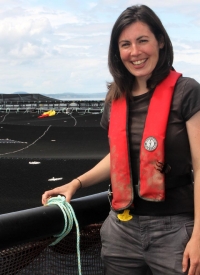
Who is in Fish Farming? - St. Croix Courier - Jul. 24, 2012
Summer Story Series: Who is Fish Farming?
Amanda Smith: One of a growing number of women who work in aquaculture
Amanda Smith will often get asked this question: Are you on the side of aquaculture or the environment?
Her answer is short and simple.
"Both," she says with a smile.
Smith is a Marine Environmental Biologist with Sweeney International Management Corporation, a St. Stephen-based company that provides aquaculture environmental management services in New Brunswick, Nova Scotia and Newfoundland.

"I don't see aquaculture as a 'one side versus the other situation'," says Smith, who lives in St. Stephen. "Im a biologist who works in the aquaculture industry and an environmentalist too. I feel I play an important role in preserving our oceans while helping our fish farmers to develop this industry."
Smith is one of a growing number of women who work in Canadas $2.1 billion aquaculture industry, which has become a magnet for women seeking full-time, year-round employment in coastal communities. Key roles in research and development, fish health, environmental sustainability, processing and communications are increasingly being filled by women. Approximately 40 per cent of Canadas 14,500 aquaculture jobs are held by women.
Smith says she knew little about aquaculture before joining SIMCorp in 2009. The focus of her science studies at Dalhousie University was genetics.
"My research focused on fruit flies. This is totally a switch, but I love it," she says.
She began her career working at the Atlantic Reference Centre of the Huntsman Marine Science Centre in St. Andrews and then with the education department of the Atlantic Salmon Federation. When a job came up at SIMCorp, Smith was eager to learn about aquaculture.
Started by Bob Sweeney about 10 years ago, SIMCorp has grown to 18 staffers, three offices and a laboratory. In the summer months, much of SIMCorps work focuses on environmental management surveys at fish farms.
Atlantic salmon farmers conduct regular government-audited on-site environmental assessments during each year of production.
Smith loves the summer the best because she can get out on the water to do her work.
"We take a chunk out of the sea floor and we analyze that sediment," she says.
She also uses a video camera to observe and record any changes to the ocean floor.
"We start about 50 metres from the cage. We can watch the sea floor as we come in from the cage and see if there is any bacterial growth, how much life there is, sea stars, urchins, see if there is any change in the colour of sediment."
If she notices any indicators such as excess feed on the floor, organic growth on the net or sediment that is dark in colour, she notifies the farmer and they work together to solve it.
She then compiles her findings - including the video footage - for the farmer and the provincial regulators.
Smith says she loves getting the chance to study the ocean floor.
"Were one of the few people who actually see the ocean bottom," she says. "A lot of sites are beautiful. You look underneath the cage and around the sea floor, there is so much life."
This summer, she will also continue her work counting lobster at a site near Grand Manan.
"The numbers were really, really interesting. The population has gone up since we collected baseline data before the site went in," she says.
She also helps conduct comprehensive environmental assessments when farmers apply for new sites or to change the boundaries on existing farms.
"We collect mud, video footage, data about currents, about the traditional fishery, wind and wave information. We even look at the labour force in the area," she says.
Smith says shes glad she found her way into the aquaculture industry and if she decides to get her Masters degree in the future, shed like to focus her research on fish farming.
"Aquaculture has given me a tremendous opportunity to do what I want to do and still stay in Charlotte County," she says.